The Role of Green Marketing Strategies in Promoting Sustainable Development
Published Online: Mar 17, 2025
Received: Oct 22, 2024
Accepted: Feb 04, 2025
DOI: https://doi.org/10.2478/amns-2025-0203
Keywords
© 2025 Hui Zhang et al., published by Sciendo
This work is licensed under the Creative Commons Attribution 4.0 International License.
In the present economic market, which is extremely rich in material and wealth, China is facing an existential crisis. For example, environmental pollution, the spread of deserts, the extinction of plants and animals, and other natural crises. Therefore, it is necessary to follow the principle of ecological balance and harmony and implement the policy of sustainable development, so as to effectively realize the development of China’s economy in harmony with the ecological environment [1-3]. Meanwhile, under the new normal, with the advancement of supply-side reform, China’s economy has gradually changed to a high-quality economic model from the past rapid development model that emphasized only quantity but not quality, and both the government and the public are paying more and more attention to environmental protection, and green consumption has become a new consumption trend, and green marketing has been increasingly emphasized by academics and enterprises [4-6]. With China’s emphasis on sustainable development, green marketing has become an emerging marketing strategy in the process of enterprise production management [7-8].
The so-called “green marketing” is actually driven by the concept of green consumption. Since the reform and opening up, although the economy has developed, it has also damaged the ecological environment to a certain extent, resulting in increasing environmental degradation [9-10]. This has hindered the sustainable development of the economy and posed a serious threat to people’s health and even the development of future generations. In this context, enterprises need to change their production concepts and actively produce green and environmentally friendly products [11-12]. The government also promotes and cultivates the public’s green consumption concept in a timely manner [13].
The improvement of economic conditions has led to a big change in people’s consumption concepts. In today’s society, the awareness of environmental protection and green consumption has been recognized by the public [14-15]. In the daily life of consumers, for the purchase of goods, more and more people take into account the issue of environmental protection, more consumers are willing to choose to buy green products under the premise of economic conditions, which is sufficient to show that the change in people’s consumption concepts has brought about a wave of green consumption [16-17]. Under the impact of this wave of green consumption, enterprises should vigorously develop products and services related to green consumption and formulate suitable marketing strategies to improve their competitiveness in the brand new green market [18-19].
Before the industrial revolution, the various chemical materials used in the production process had less impact on the environment, and the contradiction between environmental problems and economic development was relatively moderate. In modern society, economic development has brought serious environmental problems due to the production process and the excessive pursuit of economic benefits [20-21]. In order to ease the increasingly serious environmental problems, people’s economic concepts and economic behavior are gradually changing [22]. More and more people are beginning to realize that traditional production and consumption methods are threatening the environment and are threatening the survival of human beings. Only by actively changing the forms of production and consumption can we better promote the sustainable development of society [23-25].
The research firstly focuses on the sustainable development theory and green marketing theory, and explores the interaction mechanism and its process between the participating subjects such as government, consumers, environmental protection organizations and marketing subjects in the process of implementing green marketing by enterprises. The utility functions between different actors were constructed, and the system dynamics model of green marketing affecting sustainable development was constructed using Vensim PLE system dynamics software. The variables in the model were initially assigned values, so as to simulate the simulation to analyze the change trend of green marketing’s impact on sustainable development. Finally, through the structure, historical data and sensitivity, the specific path of green marketing to promote the sustainable development of enterprises from five dimensions: cost, revenue, corporate image, corporate culture, and competitiveness was examined.
This paper will study the significance of green marketing and reveal the key role of green marketing and green consumption in the realization of sustainable development from the perspectives of sustainable development theory and marketing theory, and in the study of the relationship between green marketing and green consumption, green consumption and sustainable development. This paper will firstly reveal the decisive role of green consumption on sustainable development, the synergistic role of green innovation on sustainable development, and the main role of green marketing from the derivation of the economic model of sustainable development and the methods and means of realizing it.
Accompanied by the rapid economic and social development, resource consumption and environmental problems have become increasingly prominent, and the ecological environment on which human beings rely for survival is facing a severe test. In this context, the green revolution is gradually emerging with the goal of sustainable development [26]. Since the industrial revolution, the uncontrolled development of resources and neglect of environmental protection by industrial enterprises have led to environmental problems. As the main body of national economy, enterprises are the direct main body of resource consumption and environmental use. Only when enterprises achieve efficient utilization of resources, environmental problems can be effectively controlled. The concept of sustainable development not only promotes the change of enterprise production and public consumption, but also creates the atmosphere and conditions for the development of green marketing.
Green marketing is put forward in the context of great changes in the survival environment of enterprises and society, which is both the inheritance and development of traditional marketing, but also a new marketing model and marketing concept in line with today’s green trend [27]. Therefore, green marketing, both with the commonality of traditional marketing, but also has its own characteristics. “Green” is not only an expression of a color, it has a wider social, economic, production and life connotation, which includes at least the following three levels:
The friendly attribute of environmental ecology refers to the marketing activities of enterprises not only to meet the needs of consumers, to achieve the enterprise’s profit target, but also through product design, production, pricing, distribution and other aspects of the environment into account, and strive to reduce and avoid environmental pollution, make full use of resources and promote the optimal allocation of resources, and strive to seek a balanced development of the consumer’s interests, the interests of the enterprise and the interests of the environment and ecological interests.
The friendly attribute of social ecology is an expansion of the original meaning of green marketing, which refers to the fact that enterprises, while fully satisfying consumers’ needs and realizing corporate profits in their marketing activities, pay full attention to the impact of their own behaviors on social values, ethics and morals, advocate civilized and healthy lifestyles, and rectify vulgar and malicious social and industrial customs. Strive for the harmonious development of consumer interests, business interests and social and ecological interests.
This is the sublimation of the connotation of green marketing, but also the starting point and landing point of the green marketing concept. It refers to the pursuit of sustainable development of the enterprise and the whole ecosystem on the basis of fully utilizing the benign environmental ecology and benign social ecology.
The power mechanism of enterprise green marketing refers to the interaction mechanism and its process between the government, consumers, environmental protection organizations and other participating subjects and the marketing subject in the process of enterprise implementation of green marketing. Compared with traditional marketing, the connotation and extension of green marketing is richer, and the interaction between the marketing subject (enterprise) and the participating subjects (government, consumers, etc.) is more complex. Different subjects play different roles in the process of green marketing. Therefore, we analyze and study it only from the point of view of the power mechanism it reflects.
The model of the power mechanism for enterprises to implement green marketing is shown in Figure 1. Among them, 1 refers to the government’s guidance and education of consumers, 2 refers to the government’s guidance and control of enterprises by using policies and regulations, 3 refers to the government’s support of NGOs. 4 refers to NGOs’ support and supervision of the government, 5 refers to NGOs’ supervision of enterprises, and 6 refers to enterprises’ support of NGOs. 7 refers to the pulling force of consumers’ green consumption on enterprises, 8 refers to the enterprises’ guidance and education of consumers, 9 refers to NGOs’ support of consumers’ education, 10 refers to the driving force of deep green enterprises, and 11 refers to the driving force of deep green consumers. It can be seen that the main body of the power mechanism of the enterprise to implement green marketing includes the main body of marketing (enterprise) and the main body of participation (consumers), the government and environmental protection NGOs, and they interact with each other and constitute the main source of power to promote the development of green marketing, forming a “green triangle”.
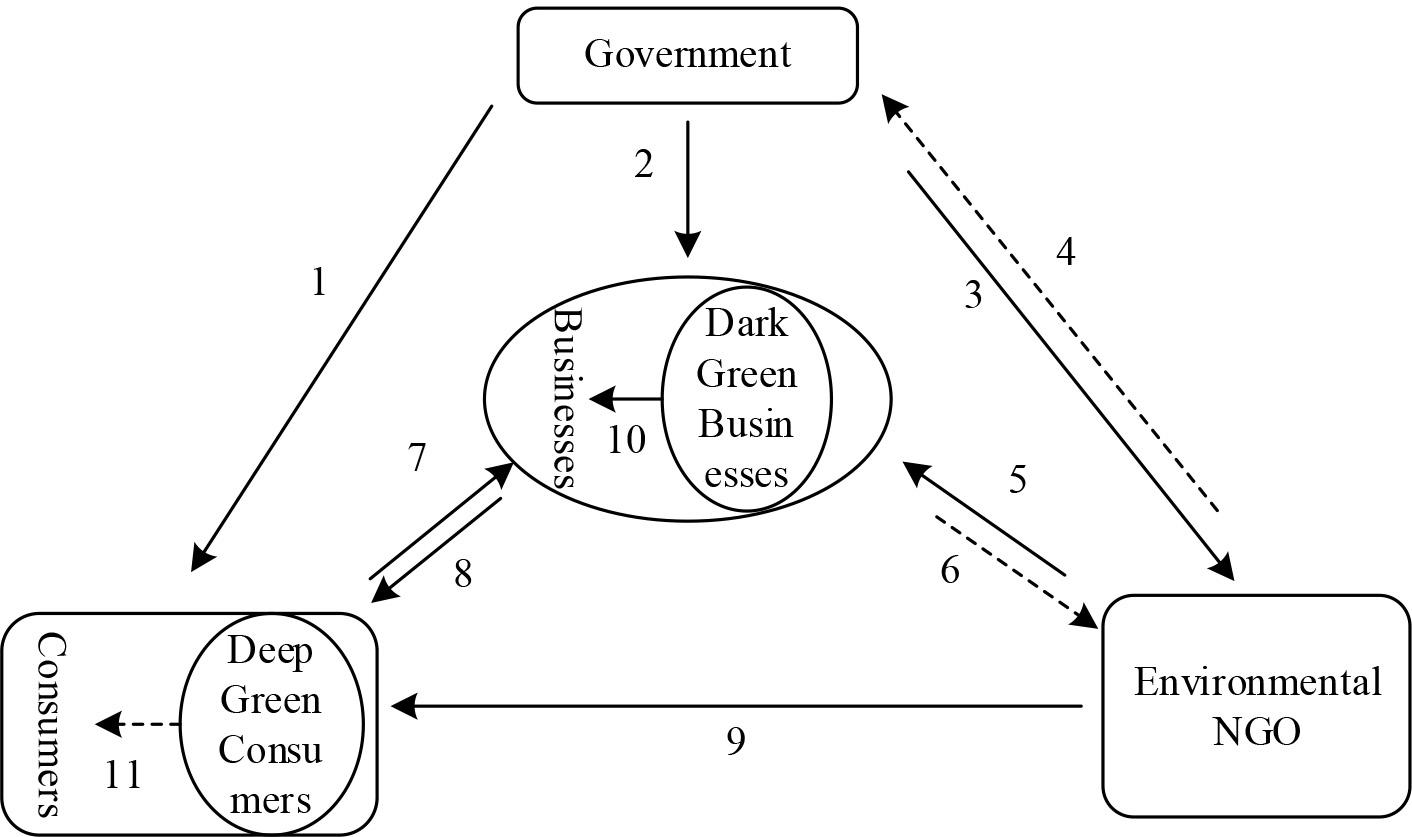
Dynamic mechanism model of green marketing
Further analysis of the sources of motivation shows that the motivation of green marketing includes two aspects:
First, the internal driving force of the enterprise, refers to the enterprise in order to adapt to the economic and social environment and meet the market demand and generated from within the enterprise, the spontaneous implementation of green marketing power source, shown in the figure for the center of the “green triangle”. The second is the external driving force of the enterprise, which refers to the marketing subject (enterprise) in the implementation of green marketing process, by the role and influence from different participating subjects, shown in the figure as the three corners of the “green triangle”.
The main body implementing green marketing should fundamentally be the enterprise, which is sufficiently motivated to implement green marketing only if it brings real benefits to the enterprise (reduced costs or increased revenue). Green marketing shows a variety of benefits, some of which are long-term, some of which are region-wide or society-wide, while the goals of enterprises may be short-term and localized. So there will be a certain conflict of interest and thus difficult to constitute the implementation of green marketing drive, this time the government needs to solve the enterprise development process of resources, the environment and the contradiction between the growth of profits and the development of a series of incentives and constraints on the economic behavior of the government, enterprises and consumers to drive the implementation of green marketing policies such as investment, taxation, prices.
The power driver provided by government behavior in the process of enterprise implementation of green marketing is shown in Figure 2, which is the external driving force for the implementation of green marketing with incentives and constraints. Only through the incentives of relevant policies and legal constraints can enterprises be mobilized to implement green marketing enthusiasm, and form a benign development trend of low inputs, high outputs and less emissions under the joint efforts of the whole society.
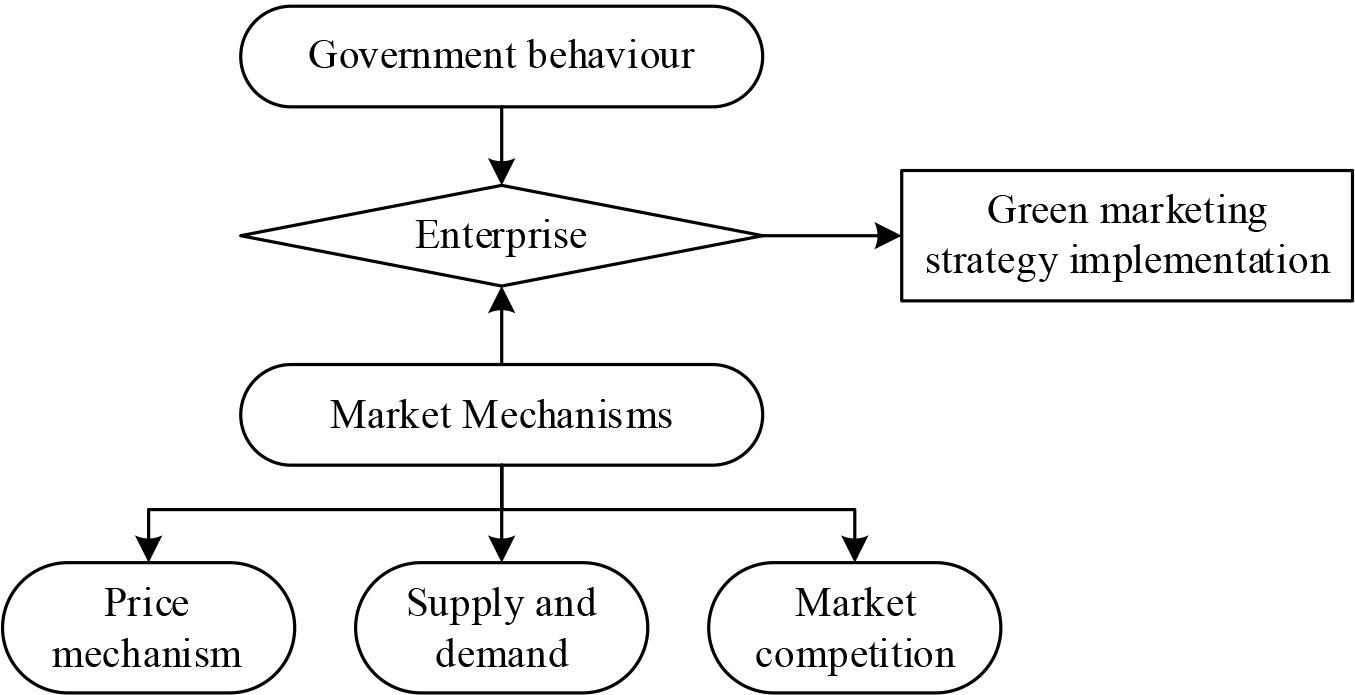
Driving factors for enterprises to implement green marketing
Among all aspects of marketing, the government, as the representative of the social public interest pressure group, is the most dynamic and authoritative party. In the power struggle between consumers and enterprises, the government’s decision-making tendency is always a most important bargaining chip, and which side the government favors will have a great impact on the green marketing often. Especially when the market dominance of consumers has not yet been determined and their market power is not enough to counterbalance, whether the government is inclined to increase supply or environmental protection will have a decisive impact on the process of green marketing.
Therefore, at the present time, when the position of the dominant player in the Chinese consumer market has not yet been established and the power of the market mechanism is not yet sufficient to regulate and guide the behavior of enterprises. The government, as the representative of social public interests and social pressure groups, should take positive and effective measures to regulate and standardize the production and operation behaviors of enterprises from the perspective of sustainable social development and the long-term interests of human beings. This will enable them to take into account the interests of enterprises, consumers and the environment, change their business practices and implement green marketing.
To promote the implementation of green marketing, it is necessary to insist on giving full play to the role of the market mechanism while the Government strongly promotes it. The market mechanism is a price mechanism, supply and demand, market competition, the three basic elements of the interlinked, mutual constraints, and promote the movement of the process, which promotes the flow of factors of production and promote the optimal allocation of resources. Its principle of action is to regulate market economic activities through changes in these three basic elements, so that market players (enterprises), driven by economic interests, take the initiative to adopt economic behaviours appropriate to the needs of the market, so that the total supply and total demand in the market constantly tends to be balanced, in order to achieve the purpose of the rational flow and effective allocation of factors of production.
At the same time, attention should also be paid to the organic combination of government regulation and market mechanisms. Government policy measures, management tools, pay attention to play a role through the market mechanism. To reasonably use a variety of economic levers, through the market value of the transmission mechanism, to guide the behavior of market players, to promote the implementation of green marketing development. This paper will be from the market mechanism of the price mechanism, supply and demand, market competition, three factors driving the implementation of green marketing to carry out subsequent research.
According to the theoretical research in Chapter 2, the influence paths of each subject of green marketing on sustainable development, and the interaction relationship are known. In order to explore the dynamic change impact of green marketing on sustainable development, this chapter utilizes the system dynamics theory and Vensim software to construct a system dynamics model, which helps to discern the impact of green marketing on sustainable development more clearly in a dynamic perspective.
System dynamics contains with feedback structure, stock flow diagrams and simulation simulation calculations based on quantitative analysis. Simulation using computer, simulation also belongs to one of the experimental methods, the evaluation and prediction of the system is carried out by constructing a simulation model [28]. Commonly used to deal with nonlinear problems in economic, social and other systems commonly used system dynamics modeling questions are solved.
Systems are constantly changing and moving, and the causal feedback loop diagram shows the relationship between the variables within the system, which is the basis and core of the system dynamics that can be used. The causal chain is often used in system dynamics to represent this causal feedback relationship, is a kind of directed line segments, positive and negative causal chains as shown in Figure 3, and the causal feedback loop is a closed loop connected by multiple causal chains. Causal feedback loops can be classified as either positive or negative polarity. The criterion for classification is the number of causal chains with negative polarity contained in the causal feedback loop, if the number is odd, it is a negative feedback loop, which represents the weakening of the cause on the effect. If the number is even, it is a positive feedback loop, which represents that the role of the cause on the effect is strengthened. Specific forms of expression shown in Figure 4.

Positive and negative causal chains
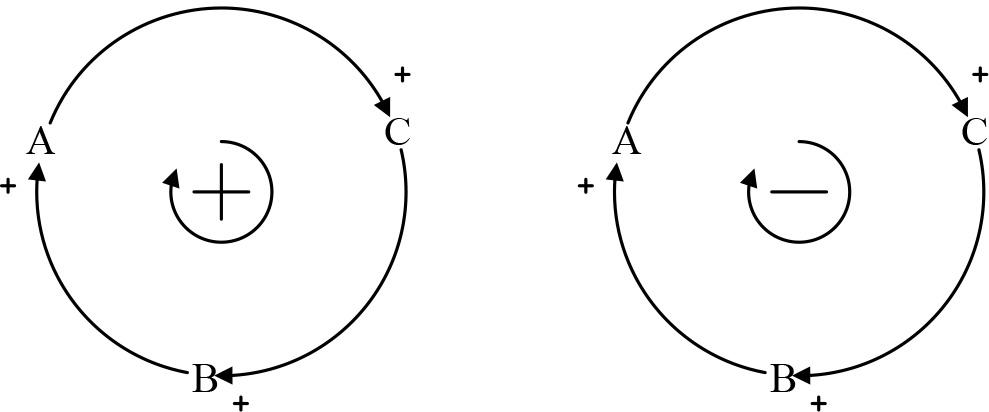
Positive and negative feedback loops
The establishment of the stock-flow diagram is the basic prerequisite for the system dynamics model to be able to run smoothly, and an important element of the modeling. Its main four types of variables are shown in Fig. 5, including state variables, rate variables, auxiliary variables and constants.
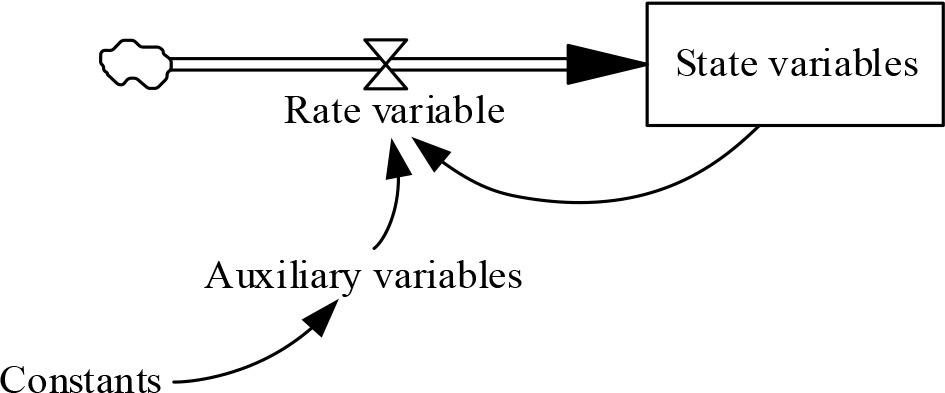
Components of a stock flow chart
It can also be referred to as a level variable or stock, which means a variable that accumulates over time in the physical flow of the system. It is expressed in the form of a rectangular box. The equation of state variable is generally represented by the following:
where
The same expression for the state variables can also be represented by discrete equations:
Among them,
It can also be referred to as flow, and its main role is to regulate how fast or slow the state variable changes. Its clothed form is a valve. The equation for the rate variable is generally represented by the following:
where
Determined by the other variables, its main role is to convert and transfer information between the state variable and the rate variable, as well as to calculate the rate variable according to the state variable. Its expression is in the form of a circle. The equations for auxiliary variables are generally expressed as follows:
where
It can also be referred to as exogenous variables, and as the name suggests, the constant values generally do not change, or change very little. The equations for auxiliary variables are generally represented by the following:
In order to construct the kinetic model of green marketing affecting sustainable development, it is first necessary to establish the utility function between the subjects of green marketing. The various actors in the implementation of green marketing by enterprises include the marketing subject (enterprises) and the participating subject (consumers), the government and environmental NGO organizations.
In order to construct the model and calculate conveniently, the following assumptions are made:
1) Local governments implement the country’s green development strategy, support green marketing in terms of funds or policies, and promote public green consumption to pay the cost of 2) Local governments that do not implement the state’s green development strategy, do not fulfill their responsibility to regulate the environment, and do not support or even oppose green marketing in terms of funding or policy will be penalized by the state, set to 3) Set the probability that the local government implements the national green development strategy and supports green marketing in terms of funding or policy as 4) The probability of the NGO’s favorable rating of the local government is consistent with its probability of fulfilling its environmental regulatory responsibilities, i.e., the probability is
Both government and consumer activities aim to maximize utility, and the value of utility is set to
In the previous section, through the analysis of the model of the driving mechanism of green marketing implementation, local governments may accept rent-seeking by enterprises or individuals from the consideration of their own short-term interests, thus relaxing the regulation of environmental issues. Government employees, as the actual implementers, are also easily induced by emotions or interests, while enterprises, as rational people, pursue interests as their fundamental goal. Green marketing will lead to short-term cost increase and profit decrease, short-sighted enterprises will choose to give up the implementation of green marketing based on the current interests. Based on this, the assumptions are as follows:
1) The only subjects of the game are the government and firms, both of which are rational, with utility functions 2) The firm’s normal state cost is 3) Assume that the probability that a firm implements green marketing is
The government’s utility function is:
The utility function of the firm is:
Value exchange is the basis for realizing resource allocation and social development. However, due to the difference of utility functions, there is an intense game between enterprises and consumers in green marketing. In order to better construct the model, the assumptions are as follows:
1) There are only two participants in the game model, namely, enterprises and consumers, and both are rational economic individuals. 2) The information between enterprises and consumers is complete, and both parties will make choices according to each other’s decisions. 3) Enterprises can choose between green marketing and traditional marketing, and consumers can buy green products and buy ordinary products. 4) The firm’s utility function is designated as
If a company implements green marketing and customers buy green products. Then
The utility function of the firm is:
The customer’s utility function is:
The purpose of establishing the system dynamics model of green marketing affecting sustainable development is to predict the future trend of green marketing affecting sustainable development, and the mechanism of its green marketing strategy on the sustainable development of enterprises, with a view to providing a certain degree of reference for enterprises to improve their green innovation performance and thus promote sustainable development.
Based on the power mechanism model of green marketing implementation constructed in the previous section, the causality loop of green marketing affecting sustainable development is drawn as shown in Figure 6. The causality loop diagram is able to represent the relationship between the subject factors, and at the same time can provide the basis for drawing the stock flow diagram and the preparation of the related equations. The arrows in the causality diagram indicate the influence of the dimensions of green marketing (MG) on sustainability (SC), and the relationship between the dimensions of green production (PN), green products (PT), green processes (TE) and green management (MT) in green marketing.
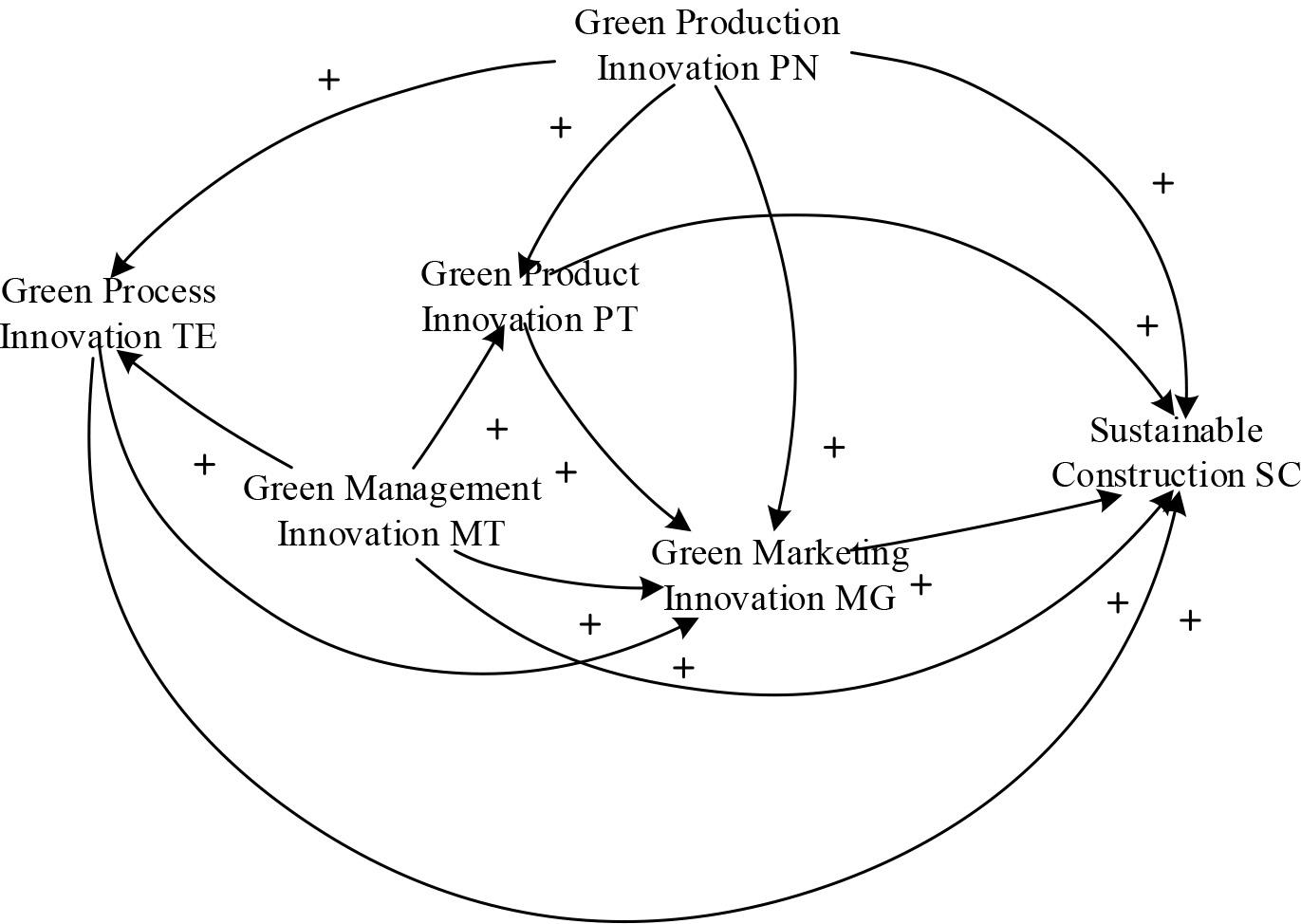
Causal loop of green marketing’s impact on sustainable development
1) System dynamics contains four main types of variables, namely level variables, rate variables, auxiliary variables and constants. Table 1 shows the definitions of parameters in the system dynamics model of green marketing affecting sustainable development.
2) Drawing of system dynamics stock flow diagrams
Through the utility function between each subject, the causality diagram containing green product subsystem, green production subsystem, green management subsystem, green process subsystem, green marketing subsystem and sustainable development subsystem is constructed, and on the basis of the causality diagram, the stock-flow diagram of the whole system of green innovation affecting sustainable construction is drawn as shown in Figure 7.
Green marketing affects the relevant variables of sustainable development system
| Nature | Content | |
|---|---|---|
| State variable | Sustainable Development (SC) | |
| Green Production (PN) | ||
| Green Products (PT) | ||
| Green Technology (TE) | ||
| Green Management (MT) | ||
| Green Marketing (MG) | ||
| Rate variable | Amount of change in Sustainable Development (SC) | |
| Amount of change in Green Production (PN) | ||
| Amount of change in Green Products (PT) | ||
| Amount of change in Green Technology (TE) | ||
| Amount of change in Green Management (MT) | ||
| Amount of change in Green Marketing (MG) | ||
| Constant | SC | Water Use Efficiency during Project construction (SC1) |
| Energy utilization efficiency during project construction (SC2) | ||
| Material utilization efficiency during project construction (SC3) | ||
| Pollution control level during project construction (SC4) | ||
| Occupational Health and Safety Management Level (SC5) | ||
| PN | Implementation of green procurement and supply green raw materials (PN1) | |
| Scientific and Reasonable design of green construction process (PN2) | ||
| Effective reduction of toxic and waste emissions (PN3) | ||
| Recovery of waste and emissions for treatment and reuse (PN4) | ||
| Reduce water, electricity, coal or oil consumption (PN5) | ||
| PT | Select product materials that produce the least amount of pollution (PT1) | |
| Select product materials that consume the least energy and resources (PT2) | ||
| Choose to use the least amount of material to produce (PT3) | ||
| Carefully consider whether the product is easy to recycle (PT4) | ||
| Avoid using materials that violate environmental regulations in the production of products (PT5) | ||
| TE | Adoption of pollution control and prevention technology (TE1) | |
| Construction Waste Reduction technology (TE2) | ||
| Use of advanced resource utilization technology (TE3) | ||
| Green Construction technology for Increased Productivity (TE4) | ||
| MT | Create a feasible green management system(MT1) | |
| Effective communication and resource sharing among departments (MT2) | ||
| Invest a high proportion of funds in green innovation (MT3) | ||
| Constantly collect new information on green innovations (MT4) | ||
| Actively introduce green advanced equipment and cultivate innovative talents (MT5) | ||
| MG | Quickly and effectively identify the market’s green needs (MG1) | |
| Green promotion, establish green marketing channel (MG2) | ||
| Green Communication and Promotion Strategy (MG3) | ||
| Establishment of corporate green brand status (MG4) | ||
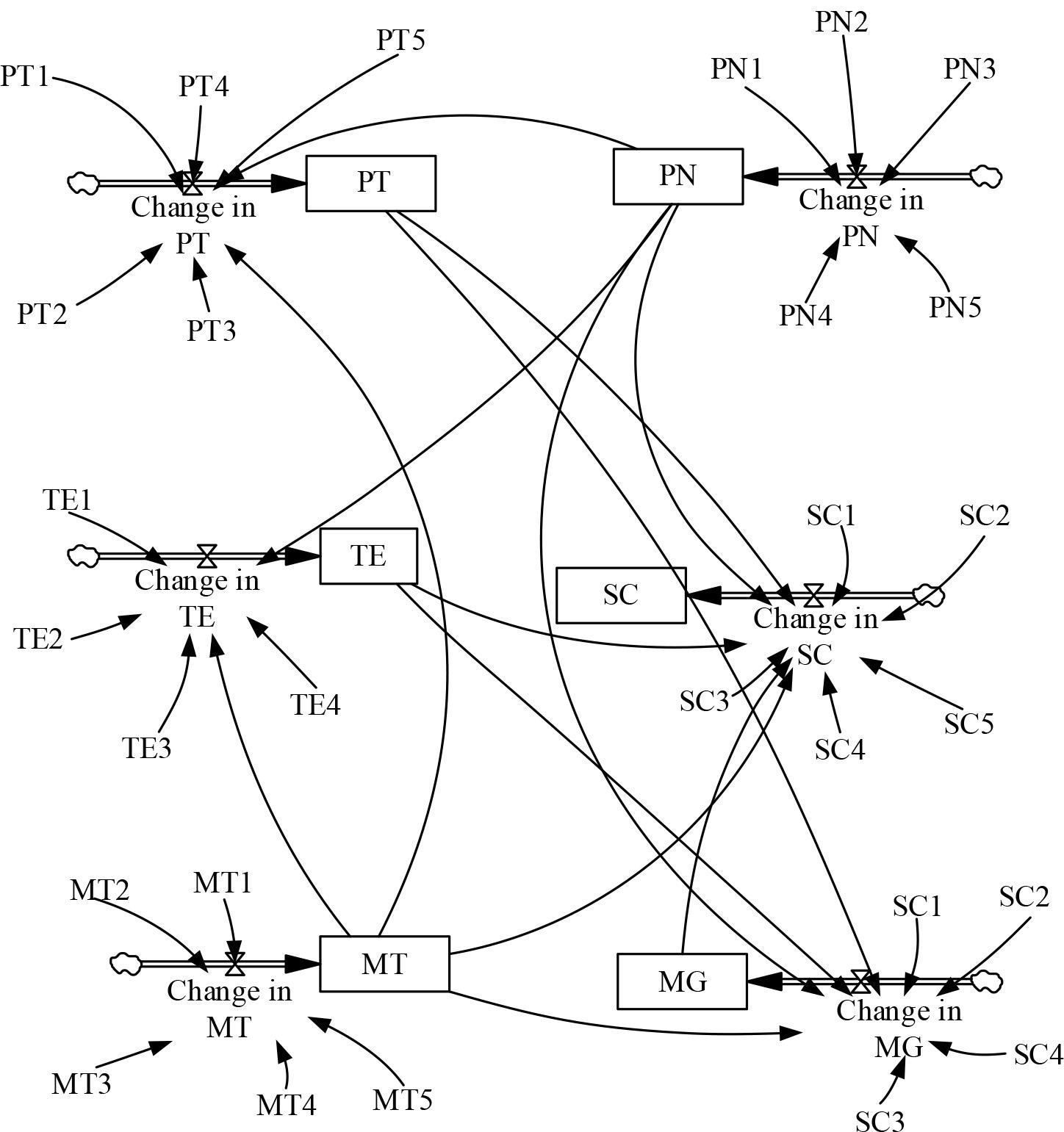
Stock flow chart of green marketing’s impact on sustainable development
The simulation of system dynamics model has the function of “policy laboratory”, by changing the parameters of different variables, it can show the different impacts of the system behaviors represented by the model under different policy conditions, so as to provide scientific references for policy making.
Under the open economy, the purpose of green marketing by industrial enterprises is to realize win-win economic-environmental performance and ultimately achieve sustainable development of human and natural environment. This paper uses Vensim PLE software to conduct policy simulation, and takes the factor of foreign capital inflow level affecting foreign direct investment (FDI), the proportion of outward investment reflecting the degree of foreign direct investment (FDI), and the proportion of international trade reflecting the scale of import-export trade as the policy variables, and designs three policy scenarios respectively as shown in Table 2. Among them, scheme 1~3 refers to the enterprises’ choice of green innovation marketing strategy, the government’s strategy of environmental regulation and the public’s strategy of monitoring through NGO organizations, respectively. Comparing the changes of the impact of open economy on the green marketing dynamics system of enterprises under different program strategies, the policy changes in different dimensions are compared and analyzed to provide scientific basis for the rational formulation of policies to enhance the green marketing dynamics of enterprises under open economy.
Simulation scheme Settings
| Variable | Increase foreign capital inflow | Expand overseas investment | Strengthening International trade |
|---|---|---|---|
| Option 1 | +10% | +0 | +0 |
| Option 2 | +0 | +10% | +0 |
| Option 3 | +0 | +0 | +10% |
In each scenario, by changing the values of three policy variables, this paper will explore the impacts on the three dynamical systems of technology push, market pull and environmental regulation push in sustainable development (SC) when the three variables are changed respectively. Among them, since the level of R&D investment can measure the strength of a country’s innovation drive, the higher the level of R&D investment, to a certain extent, reflects the stronger green marketing drive. Therefore, this paper selects two indicators of green marketing personnel capital investment and green marketing R&D capital investment in the technology driving force subsystem to reflect the impact of changes in the open economic environment on the green marketing technology driving force of industrial enterprises. Market demand and market competition intensity are important indicators reflecting the market pulling power of green marketing, and appropriate market demand and market competition intensity will enhance the power of green marketing of enterprises. Therefore, this paper analyzes the impact of changes in the open economic environment on the market pulling power of green innovation of industrial enterprises by selecting two indicators in the market pulling power subsystem: market green demand and enterprise net green marketing profit accumulation, which represent the market demand and the degree of market competition, respectively. The more investment in environmental pollution control, the stronger the impetus for environmental control. Therefore, the two indicators of operating costs of pollution control facilities and investment in environmental pollution control are selected in the environmental control driving force subsystem to reflect the impact of changes in the open economic environment on the environmental control driving force of industrial enterprises’ green marketing.
Enterprises carry out green marketing is conducive to reducing pollution to the environment and enhancing the social benefits of enterprises, but at the same time, they need to pay a higher cost of green marketing. The impact of cost on the enterprise green marketing strategy is shown in Figure 8, when the cost of enterprises to carry out green marketing increased from the initial value of 0.4 to 0.5 (curve 2), enterprises to carry out green marketing, although the final evolution to the stable equilibrium point 1, but its evolution time is significantly longer, the initiative is reduced. When the cost of the enterprise to carry out green marketing increases greatly, increasing to 1 (curve 1), the enterprise strategy choice as shown, the probability of the enterprise to carry out green innovation is subsequently reduced, gradually tilted to 0, until finally reaching the stable state of not carrying out green marketing. When the enterprise green marketing cost is reduced from the initial value of 0.4 to 0.2 and 0.1 respectively, the corresponding curves are Curve 3 and Curve 4. It can be seen that the line is getting steeper and steeper compared with Curve 5, and the enterprise’s initiative to carry out green marketing is obviously improved, and the time for evolution to the point of stable equilibrium is also greatly shortened.
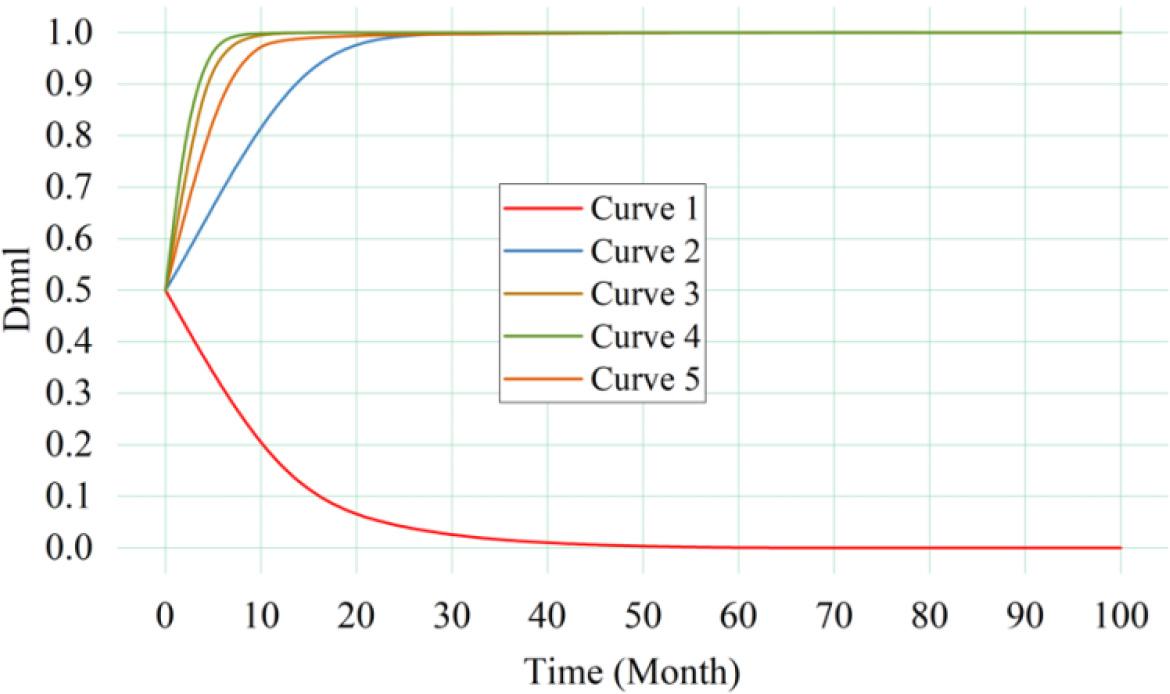
Impact of cost on enterprises’ green marketing strategies
Therefore, the strategic choice of enterprises is very sensitive to the cost of green marketing, especially when the cost increases to a certain value, even if the government at this time to implement a strong regulatory strategy, enterprises will give up the choice to take the initiative to green marketing strategy.
The influence of expected returns on the strategic choices of enterprises and governments is shown in Figure 9, and similar to the evolutionary pattern of green marketing costs, when the value of the enterprise’s green marketing returns decreases to a certain value, the evolutionary trend also appears to change in the opposite direction. The initial state of the gain is curve 4, when the expected gain increases from the initial value of 1 to 1.2 (curve 1), it can be visualized from the trend of change that the initiative of the enterprise to choose to carry out green marketing rises significantly and evolves to the equilibrium state earlier than curve 4, indicating that the increase in the gain of the enterprise to carry out green marketing has given the enterprise a great impetus, and the enterprise’s initiative to carry out green marketing is significantly improved. And when the expected return of enterprise green marketing is reduced from the initial value of 1 to 0.9 (curve 2), the evolution of the enterprise to the equilibrium point 1 is obviously slowed down, and the initiative is reduced. And continue to reduce the value to 0.5 and 0.7, at this time the enterprise and the public strategy choice for curve 3 and curve 5, respectively, the enterprise innovation strategy choice appeared the reverse change, its willingness to carry out green marketing is obviously reduced until the evolution to the equilibrium state 0 place. Due to the low expected return value, the enterprise will eventually choose not to carry out green marketing.
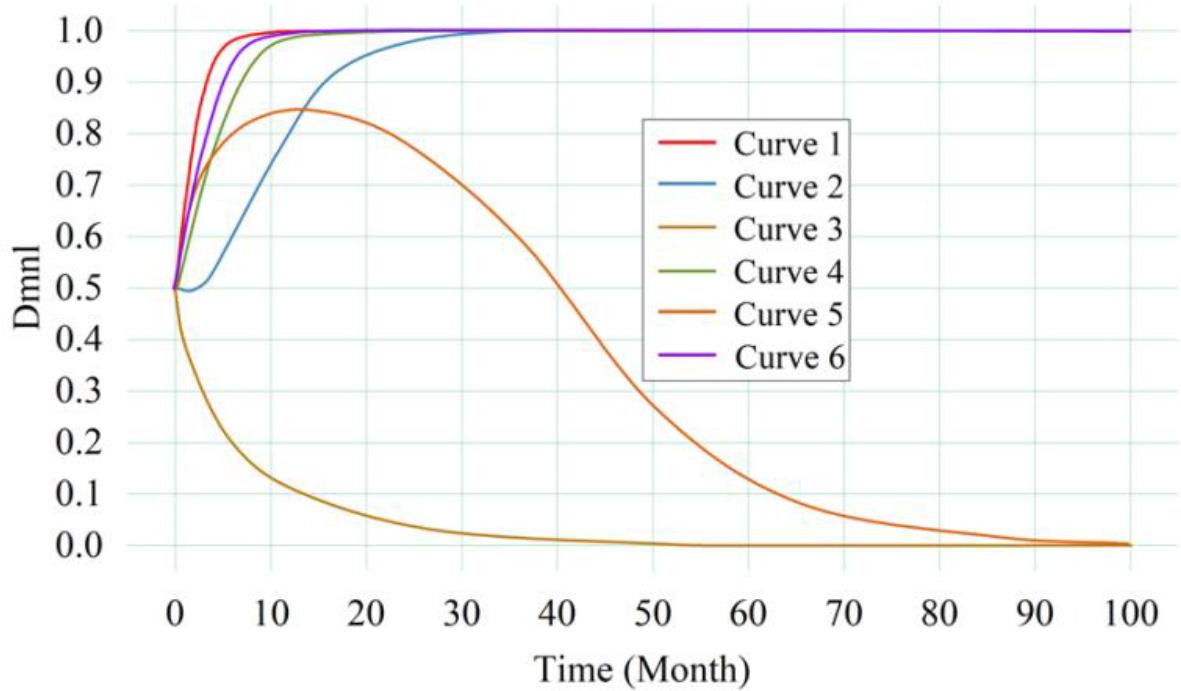
Influence of expected income on the strategic choice of enterprises and governments
The above simulation results are consistent with the reality that when the expected benefits of green marketing are very low, enterprises will often choose not to carry out the strategy in order to ensure their own interests. In order to increase the incentives for enterprises to engage in green marketing, the government will strengthen the environmental regulatory constraints in order to encourage enterprises to engage in green marketing and environmental governance.
In the case of green marketing by enterprises, public participation in monitoring can obtain certain benefits. The simulation results of the expected gain of public participation in supervision on the influence of public strategy are shown in Fig. 10, which shows that when the exogenous variable takes the initial value, the public, whether it is mutated from 0 or 1, will eventually reach a stable equilibrium, i.e., participation in supervision, in 1. Among them, curve 5 is the initial value of the public participation in monitoring the expected benefits of 1. When the initial value is increased from 1 to 1.1 and 1.2, the trend of the public strategy change corresponds to curve 2 and curve 1, respectively, and it can be seen that the greater the benefits, the steeper the curve, the sooner it reaches a stable equilibrium at 1. When the initial value decreases from 1 to 0.9 and 0.8, the curves corresponding to the public strategy change are curve 3 and curve 4, respectively, and it can be seen that the smaller the gain, the lower the public’s initiative to monitor, and the longer the evolution to the stable equilibrium point 1. Therefore, the benefits received by the public are also an important factor influencing the level of their willingness to monitor.
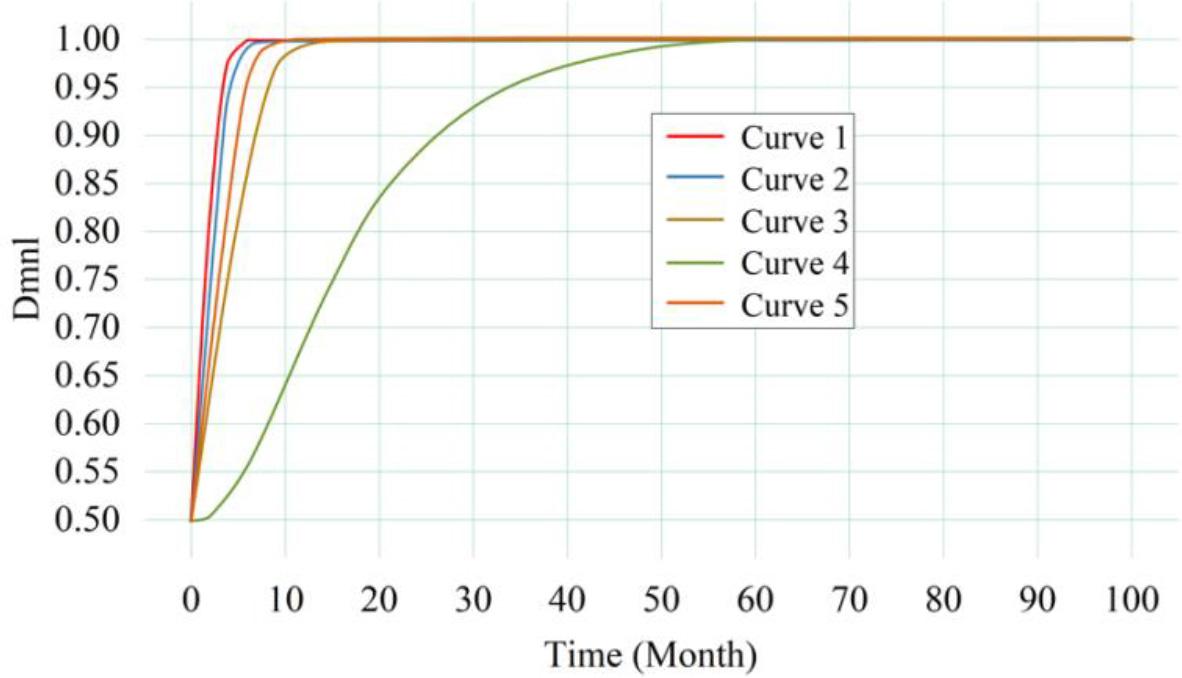
The effect of the benefits of public participation supervision on strategy selection
In this paper, a large number of parameters are set in the stock and flow model to reflect the real behavior as realistically as possible, but this may also lead to system instability and parameter insensitivity, and sensitivity testing is an important way to verify the validity of the parameters affecting the behavior of the stock and flow model. In this paper, the sensitivity of the model is tested by Monte Carlo analysis of Vensim DSS, which can be used to check the effect of input parameters on output variables and to calculate confidence bounds by simulation. For this model, several parameters need to be tested, including fiscal, tax, financial, technological and environmental policies, and the specific parameter settings are shown in Table 3.
Parameters setting for the sensitivity test
| Policy instrument | Argument | Initial value | Range of variation |
|---|---|---|---|
| Fiscal policy | The proportion of industrial pollution control investment in GDP | 0.00098 | [0, 0.003] |
| Tax policy | Environmental tax rates fluctuate | 0 | [0, 0.1] |
| Financial policy | Green credit interest rate floating | 0 | [-0.05, 0.05] |
| Science and technology policy | Government R&D expenditure as a percentage of GDP | 0.13288 | [0, 0.03] |
| The proportion of enterprise capital to GDP in enterprise R&D investment | 0.13315 | [0, 0.02] | |
| Environmental policy | The transaction price of waste water discharge branch fluctuates | 0 | [0, 0.04] |
| The trading price of waste emission rights fluctuates | 0 | [0, 0.04] |
The evolutionary trajectory of the output variable (green marketing) with different parameter values, using the variable representing the policy instrument as the input variable, is shown in Figure 11. Among them, Fig. 11 (a) to (e) refer to the evolutionary trajectories of the five parameters of fiscal, tax, financial, technological and environmental policies on firms’ choice of green marketing, respectively. The confidence boundaries for different values are indicated by different color areas, with gray, orange, and green indicating 100%, 95%, and 75% confidence boundaries, respectively. The black line represents the average of 500 values randomly sampled from the uniform distribution specified by the Monte Carlo analysis of the Vensim DSS. It can be seen that the evolutionary trajectory of the firm’s choice of green marketing strategy with respect to the five parameters fluctuates considerably, indicating that it is sensitive to all input parameters, which also suggests that the parameters in the governmental behavior subsystem can affect green marketing by acting on other variables in other subsystems. In addition, it can be seen that green marketing is more sensitive to changes in the values of fiscal policy, tax policy and science and technology policy.
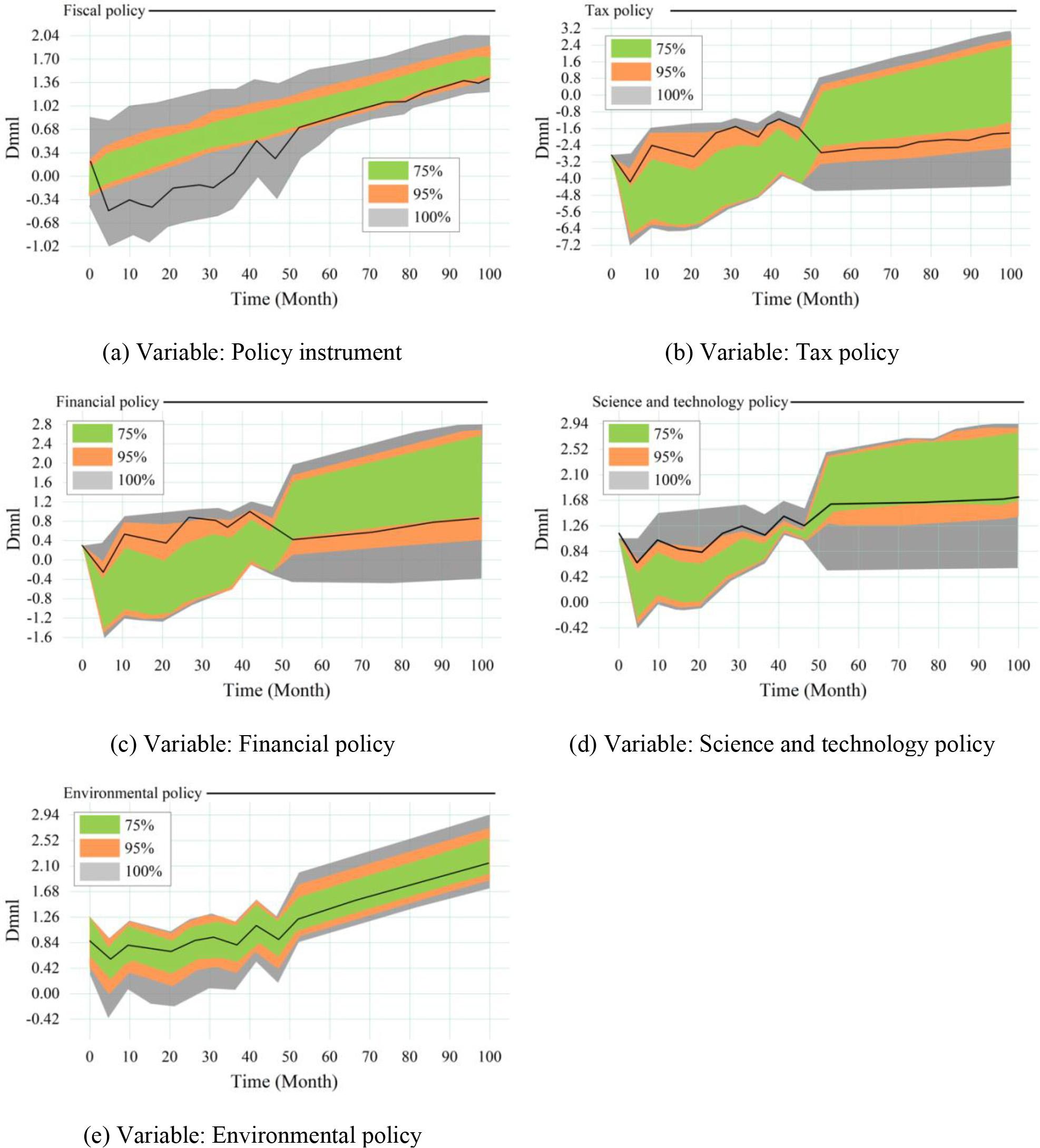
Sensitivity test: Evolution trajectory of green marketing under different parameter value
In summary, from the results of structural test, historical data test and sensitivity test, it is clear that the model proposed in this paper is reasonable and scientific.
Through the above simulation analysis of the kinetic model of green marketing affecting sustainable development, it is found that green marketing can promote the sustainable development of enterprises through five aspects: cost, revenue, corporate image, corporate culture, and competitiveness:
Green marketing requires avoiding excessive packaging of products, and emphasizes the reuse of containers, the second-degree utilization or sale of waste, etc., all of which can reduce the production costs of enterprises. Thus, a small amount of quality management expenditure for the enterprise to obtain greater benefits. In the long run, this circular economy model, which replaces the linear hierarchy, will ensure full utilization and minimal consumption of resources, making them less expensive and contributing to long-term cost reductions for enterprises.
With the increasing green awareness of consumers, the green consumer market of green products and services with huge market potential is gradually formed, and through green marketing, enterprises can obtain abundant economic benefits. At the same time, green industries with great development prospects, such as the environmental protection industry, etc., indicate that enterprises may obtain excellent new market opportunities and the corresponding lucrative returns. In this way, through green marketing, enterprises have undoubtedly found a new product development or investment direction, and a new profit growth point, thus ensuring the sustainable development of enterprises.
In the increasingly fierce market competition, environmental protection is more and more important today, enterprises want to be invincible among the many competitors, to establish a green corporate image is essential. A survey shows that the public evaluation of the operation of enterprises, in addition to price, quality, service, but also “environmental protection”, “public image” and so on. Green marketing can establish a good corporate and brand image for the enterprise, thus helping the enterprise to win customers and markets. And promote its good relations with consumers, the government and society, to open the door for the operation of the enterprise, and become an important intangible asset of the enterprise and the long-term development of favorable protection.
Corporate culture serves as the common values of the company, which binds and guides the behavior of the employees. A good organizational culture can also have a great motivational effect on employees. Green marketing requires companies to pay attention to the earth, treat the environment well, pay attention to fairness, the pursuit of harmony, but also has a strong humanistic color, which helps companies to establish a positive organizational spirit, high organizational values, perfect organizational image. Thus, it helps to establish a good corporate culture, enhance the sense of identity of the employees and the cohesion of the organization, and improve the moral integrity and loyalty of the employees.
The implementation of green marketing strategy, on the one hand, is conducive to enterprises to take one step earlier to seize a favorable position, so that enterprises to obtain more market share. On the other hand, the positioning of the enterprise is different from that of its competitors, thus occupying a relative competitive advantage. At the same time, through continuous cost reduction, good organizational culture and corporate image, product development and investment sustainability. The implementation of green marketing strategy also contributes to the establishment, improvement and strengthening of the core competitiveness of the enterprise, and becomes the source of lasting competitiveness of the enterprise, which strongly guarantees the sustainability of the development of the enterprise.
This paper takes the research objective of exploring the mechanism of enterprise sustainable development enhancement under the perspective of green marketing, and judges the mutual influence relationship between the dimensions of green marketing. And based on the influence relationship, the power mechanism of green marketing implementation is constructed. On the basis of the utility function between green marketing subjects, a system dynamics model of green marketing affecting sustainable development is established, and the Vensim-PLE system dynamics simulation software is used to simulate and analyze the constructed model in a relevant way. The study found:
1) The strategic choice of enterprises is very sensitive to the cost of green marketing, especially when the cost increases to a certain value, even if the government implements a strong regulatory strategy at this time, enterprises will give up the choice to take the initiative to carry out green marketing strategy. 2) When the enterprise to carry out green marketing expected revenue is very low, enterprises in order to ensure their own interests, often choose not to carry out the strategy. In order to increase the motivation of enterprises to carry out green marketing, the government will strengthen the environmental regulatory constraints, in order to promote enterprises to carry out green marketing and environmental governance. 3) In the case of green marketing by enterprises, public participation in monitoring can obtain certain benefits. The lower the benefit, the lower the public’s initiative to supervise, the longer it takes to evolve to the stable equilibrium point 1, and the benefit gained by the public is also an important factor affecting their willingness to supervise.
